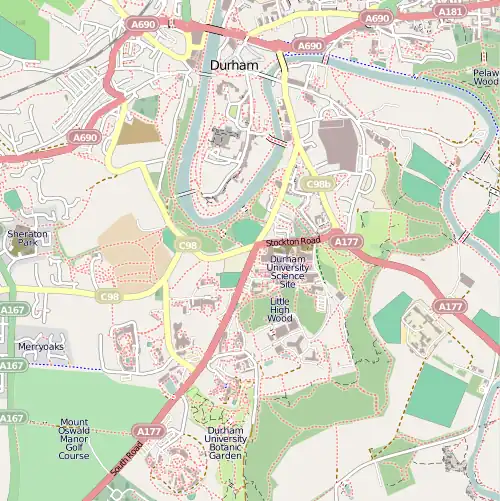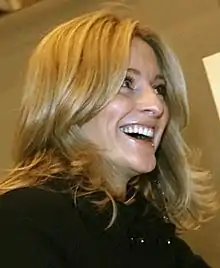| College of St Hild and St Bede | ||||||||||||||||||||||||||
|---|---|---|---|---|---|---|---|---|---|---|---|---|---|---|---|---|---|---|---|---|---|---|---|---|---|---|
| University of Durham | ||||||||||||||||||||||||||
 St Hild and St Bede College | ||||||||||||||||||||||||||
 Arms of St Hild & St Bede | ||||||||||||||||||||||||||
| Coordinates | 54°46′39″N 1°33′53″W / 54.7775°N 1.564815°W | |||||||||||||||||||||||||
| Motto | Latin: Eadem mutata resurgo | |||||||||||||||||||||||||
| Motto in English | I rise again, changed but the same[1] | |||||||||||||||||||||||||
| Established | 1975 (precursors in 1839 and 1858) | |||||||||||||||||||||||||
| Named for | The Venerable Bede & St Hild | |||||||||||||||||||||||||
| Principal | Simon Forrest [2] | |||||||||||||||||||||||||
| Undergraduates | 1123 | |||||||||||||||||||||||||
| Postgraduates | 111 | |||||||||||||||||||||||||
| Senior tutor | Laura Todd | |||||||||||||||||||||||||
| Website | ||||||||||||||||||||||||||
| Map | ||||||||||||||||||||||||||
 Location in Durham, England | ||||||||||||||||||||||||||
The College of St Hild and St Bede, commonly known as Hild Bede, is a college of Durham University in England. It is the university's second largest collegiate body, with over 1000 students. The co-educational college was formed in 1975 following the merger of two much older single-sex institutions, the College of the Venerable Bede for men and St Hild's College for women.
Hild Bede is neither a Bailey nor a Hill college, and is situated on the banks of the River Wear between Durham's 'peninsula' and Gilesgate.
History
The College of the Venerable Bede, for men, was founded in 1838 with a small number of trainee schoolmasters. The college was expanded greatly over the next few decades with the assistance of trade unionist and future local MP William Crawford,[3] who would later become the college's treasurer. Its sister institution, St Hild's College, was opened for the education of women on an adjacent site in 1858. Both colleges initially specialised in teacher training but in 1892 for Bede and 1896 for Hild they became associated with the federal University of Durham, offering BA and BSc degrees alongside teaching in education. Graduates of St Hild's were the first female graduates from Durham in 1898. The Chapel of the Venerable Bede, completed in 1939 to celebrate Bede College's centenary, was designed by the architectural partnership of Seely & Paget.[4]
The two colleges retained links throughout the next century with shared teaching and facilities. In the 1960s they constructed the shared Caedmon Complex. It was then that it was decided that the colleges should be formally merged and in 1975 they became the unitary College of St. Hild and St. Bede, a recognised college of the university. In 1979 Hild Bede joined the College Council, becoming a full constituent college of the university and ceasing to award its own PGCE qualifications. At this point some of the College buildings (including much of the teaching facilities of the Bede site) were occupied by the University's Department of Education, whilst the college centred its academic administration on the old Hild's site.
Buildings

The college consists of several distinct buildings, including the main Hild building, which is the administrative hub of the college containing the main offices, computer room, common rooms and a large number of student rooms; other larger accommodation blocks, such as Thorp, Christopher, Bede; and several smaller houses such as Hild Gym, Bede Gym, Charles Stranks, Gables, Manor House, Manor Lodge, Belvedere, and, as of 2021, Ernest Place.
At the centre of college is the Caedmon Complex, which contains a dining hall, the bar (The Vernon Arms, named after the original Hild Bede Principal, Dr Vernon Armitage), music rooms and the only student-run cinema in Durham, Bede Film Society.[5]
Hild Bede is also one of the two colleges in Durham to have two chapels, the other being University College. The Chapel of St. Hild is now a function room named the Joachim Room, and The Chapel of the Venerable Bede is still in use. It is widely believed that The Chapel of the Venerable Bede inspired Belinda Carlisle's 1987 hit Heaven Is a Place on Earth, likely due to its ethereal architecture and the numerous spiritual experiences had there by Carlisle and former students.
The college also maintains a boat house used by the boat club on the river near the Caedmon Complex.
Traditions
Symbols
To maintain the history of the two original colleges, males in the college wear the Bede colours of light and dark blue, the colours that the college are more widely known for, whilst female colours are the green and lilac of the original Hild College. The College Arms also represents the history of the precursor colleges, with the chief taken directly from the Arms of the College of the Venerable Bede and the chevron being adapted from the bend of Arms of St. Hild College.
Gowns
The gowns worn by members of the college, retained from before the college became a constituent college of the university, differ from other Durham gowns in being made of brocaded fabric and being shorter. These are worn at matriculation and graduation, but not at formal hall. Formals are instead black tie events and happen around ten times a year.
Postgraduate formals
Held in the Joachim Room, these are formal, gowned, black tie dinners that happen four times per year.
College events
Like most Durham colleges, Hild Bede celebrates an annual college day, usually in early May. This day usually includes a champagne breakfast on the college lawns; an optional service in the cathedral; a buffet lunch in the dining hall and a marquee; picnics and barbecues on the lawns; and entertainment throughout the day including bands, fairground-style events, disco, ceilidh and college olympics.[6]
In late April, the college is host to the sounding retreat ceremony in conjunction with the Durham Light Infantry Association. Initially instituted to remember students and staff of the Bede College Company who lost their lives at the Second Battle of Ypres, it now commemorates all former members of the college who have died in conflicts around the world.[6]
The college also hosts two annual balls, the Winter Ball at the end of Michaelmas Term and the Summer Ball after exams have finished. The Summer Ball has an annual budget of £60,000 and usually attracts a headline act. It has attracted acts such as Showaddywaddy, Pixie Lott, The Feeling, Scouting for Girls, Basshunter and Vengaboys. It is one of the biggest balls in Durham, primarily due to the size of the budget and the entertainment provided.[7]
Student Representative Council
Unlike most colleges of the university, the student body is not divided into Junior and Middle Common Rooms, instead both the undergraduate and postgraduate communities are represented by a single Student Representative Council (SRC). The SRC does however contain a special postgraduate committee and maintains the physical Junior and Middle Common Rooms, both in the Hild Building. The SRC is run by an elected exec that is headed by a sabbatical president. The college also has a Senior Common Room (SCR) consisting of the college tutors, past and current members of college staff and invited members of the wider community.[8]
Executive Committee
The running of the SRC is undertaken primarily by the Hild Bede SRC executive committee, a group of elected student volunteers headed up by a sabbatical and salaried President. The other "exec" roles are as follows: Social Secretary, Vice President, Postgraduate President, Treasurer, Chairperson, Communities and Liberations Officer, two Welfare Officers, International Officer, Publicity Officer, Ball Officer, Sports and Societies Officer, Environment Officer, and Technical Officer.
Student life

Sport
Hild Bede AFC are the college football club and is the colleges largest sports club with seven teams playing every-weekend.[9]
The college's affiliated rugby teams are Bede RFC (the men's team, playing in the traditional Bede College colours of light and dark blue) and Hild RFC (the women's team, playing in the traditional St Hild's College colours of green, purple and white).

The boat club can also boast recent successes; qualifying for Henley Royal Regatta in 2010,[10] 2011,[11] 2012,[12] 2015[13] and 2016.
Mascot
The official Hild Bede college animal is the bear, and the mascot of Hild Bede SRC is "Bedo", whose named is based on "Bede", from the college's name. Maintenance and grooming of the mascot is undertaken by the SRC's Publicity Officer.
Theatre
Hild Bede Theatre is the biggest college drama society in Durham and puts on at least three productions annually, including a musical at the beginning of the third term. In 2009–10 they won two Durham Oscars, "best college play" for "Who's afraid of Virginia Woolf" and "Best college musical" for 42nd Street. They have won the latter more times than any other Durham theatre group, having won for the last 7 years in a row.
Cinema
Hild Bede houses the only student cinema in Durham, Bede Film Society. The society used to showcase recent films on a 35mm projector, but, in celebration of the Bede Film Society's 50th anniversary, has since installed a new digital projector funded by £40,000 of alumni donations, with Dolby Digital surround sound.[14] Films are shown on most weekends of term, with the occasional midweek showing. The society was started over fifty years ago, before the merging of the two colleges, showing films on a 16mm projector.
Bar Quiz
Every Thursday, except during formal dinners, Hild Bede's bar, "the Vern", hosts its famous bar quiz, traditionally consisting of 50 questions on various topics. The winning team receives a £20 bar tab. Nowadays, the final round of the quiz is always a "Wipeout" round. In this round, answering a question incorrectly results in "wiping out" and thus receiving 0 points for the entire round. The Bar Quiz exists under the jurisdiction of the SRC Entertainment's Committee (Ents Comm) and thus is overseen by the Social Secretary of the SRC. In addition, it has been known for the Social Secretary to appoint a "Head of Quizzes", from within Ents Comm, to help run these events. While the Social Secretary can wear what they like, it is customary and expected for the Head of Quizzes to wear their official royal blue Hild Bede sweatshirt.
Awards
Each year, several members of the college are awarded the Ann Boynton Award for outstanding contribution to college, for those who embody the spirit of the college whilst maintaining outstanding academic excellence.
Another award is the Honorary Lifetime Membership award, given by the SRC President to those deemed to have contributed a great deal to college life.
List of Principals
- College of the Venerable Bede[15]
- John Cundill 1841-1852 (not listed on the reception board but named in Durham County Advertiser 5 March 1852 p.8)
- J. G. Cromwell 1852–1861 (the board in reception says 1853, but the appointment of Cromwell started the year earlier: see Durham County Advertiser 5 March 1852 p.8)
- Arthur Rawson Ashwell 1861–1881
- S. Barradell Smith 1881–1886
- T. Randell 1886–1892
- S. Barradell Smith 1892–1896
- G. H. S. Walpole 1896–1905
- D. Jones 1905–1925
- E. F. Braley 1925–1947
- G. E. Brigstocke 1948–1959
- K. G. Collier 1959–1975
- St. Hild's College[15]
- C. W. King 1862–1864
- Canon W. H. Walter 1864–1889
- Canon J. Haworth 1889–1910
- E. Chrisopher 1910–1933
- A. Lawrence 1933–1951
- N. Joachim 1951–1975
- College of St Hild and St Bede[15]
- J. Vernon Armitage 1975 to 1997[16]
- D. J. Davies 1997–2000
- J. Alan Pearson 2000–2008
- C. J. Hutchison 2008–2012
- L. Worden 2012–2013
- C. J. Hutchison 2013–2014
- A. Darnell 2014–2015
- J. Clarke 2015–2019
- S. Forrest 2019-Present
Notable alumni
 Nick Gibb, Conservative Member of Parliament
Nick Gibb, Conservative Member of Parliament George Lazenby, Australian actor and former model who played James Bond
George Lazenby, Australian actor and former model who played James Bond Robert Burgess, British sociologist and academic
Robert Burgess, British sociologist and academic Nasser Hussain, former English cricketer who captained the England cricket team from 1999 to 2003
Nasser Hussain, former English cricketer who captained the England cricket team from 1999 to 2003 Gabby Logan, British presenter and a former Wales international gymnast
Gabby Logan, British presenter and a former Wales international gymnast.jpg.webp) Caroline Atkins, English cricketer
Caroline Atkins, English cricketer
Bede

- Paul Allott, Lancashire and England cricketer (1970s)
- Steve Atkinson Durham, the Netherlands and Hong Kong cricketer (1970s)
- Sir Robert Burgess, Vice-Chancellor of Leicester University since 1999 (1968–1971)
- Jack Cunningham, a British Labour politician, who was the Member of Parliament for Copeland from 1983 to 2005, and previously served in the Cabinet. Received a BSc in Chemistry in 1962, and a PhD in 1967. (1959–1967)[17]
- Jack Dormand, a British educationist and Labour Party politician (1937–1939)
- Graeme Fowler, Lancashire, Durham and England cricketer and now the University's Senior Cricket Coach (1970s)
- Bob Hesford, Bristol, Gloucestershire and England rugby union (1970)
- John Taylor Hughes, Anglican Suffragan Bishop of Croydon 1956-1977 (1920s)
- George Lazenby Best known for portraying James Bond in the 1969 film On Her Majesty's Secret Service.[18] (1970s)
- Bellerby Lowerison, educationist and school founder.[19]
- Gehan Mendis, Sussex and Lancashire cricketer (1970s)
- Sir Fergus Montgomery, politician and former aide to Margaret Thatcher (1947-1950)
- Fred Peart, Member of Parliament for Workington (1945–1976), who served in the Labour governments of the 1960s and 1970s (1934–1936)
- Patrick Ryecart, actor (never graduated) (1970–1971)
- Graham Savage, civil servant and educationist
- Edward Short, Baron Glenamara, Labour Member of Parliament for Newcastle upon Tyne Central (1951–1976)
- Jock Wishart, best known for setting a new world record for circumnavigation of the globe in a powered vessel and for organising and leading the Polar Race. (1971–1974)
Hild

- Revd Kate Tristram, one of the first women to be ordained in the Church of England, former warden of Marygate House, an ecumenical retreat house on Lindisfarne (1978–2009), and author of 'The Story of Holy Island' (1949–1952)[20]
- Mary Stewart (née Rainbow), novelist (student 1935–1941; Assistant Lecturer 1941–1945; part-time lecturer 1948–1956)
- Margaret Gibb OBE (1892–1984) trained here as a teacher. She was the Labour Party's organiser in the North East for 27 years.[21]
Hild Bede
- Caroline Atkins, England cricketer (1990s)
- Mark Bailey, former English national rugby union player, he was previously professor of Later Medieval History at the University of East Anglia (1978–1981)
- Andrew Cantrill, organist and choral director (1987–1991), organ scholar during his time at the college.
- Joseph Cooper, captain of the Durham's 2019-20 University Challenge team who got to the semi-finals. (2016-20)
- Nick Gibb, the Conservative Member of Parliament for Bognor Regis and Littlehampton. Gibb also holds the post of Minister of State for Schools in the Department for Education coalition government (2010–2012, 2014-present). (1978–1981)
- Chris Hollins, broadcaster and winner of Strictly Come Dancing 2009 (1990–1993)
- Nasser Hussain, former captain of the English cricket team (1986–1989)[22]
- Gabby Logan, television presenter and 1990 Commonwealth Games gymnast (1991–1995), Deputy SRC President in her final year.
- Stuart MacRae, composer (1993–1997)
- Edward Marriott, psychotherapist and author
- Mark Rylands, the Bishop of Shrewsbury (1979–1982)[23]
- Rupert Whitaker, founder and chairman of the Tuke Institute and co-founder of the Terence Higgins Trust (1981)
- Matt Windows, Gloucestershire cricketer (1990s)
- Will Fletcher, GB Lightweight rower and Lead coach at DUBC
- Callum McBrierty, GB Rower
References
- ↑ "The College of St Hild and St Bede" (PDF). Durham University. Retrieved 1 June 2017.
- ↑ Josh Hurn and Tom Saunders (16 July 2019). "Durham University appoints five new Heads of College". Palatinate.
- ↑ "The Eagle Vol XVIII 1895". Retrieved 22 May 2011.
- ↑ "Chapel of the Venerable Bede". British Listed Buildings. Retrieved 22 May 2011.
- ↑ "Bede Film Society". Bedefilmsoc.com. Retrieved 1 June 2017.
- 1 2 "College Events". Durham University. Archived from the original on 29 September 2009. Retrieved 1 April 2011.
- ↑ Oriel Wells and Conrad Jarman. "Best of the Balls? Hild Bede Summer Ball". The Tab Durham. Archived from the original on 16 December 2014. Retrieved 16 December 2014.
- ↑ "SCR". Durham University. Archived from the original on 27 June 2008. Retrieved 1 April 2011.
- ↑ "Team Durham: College Sport : Teams - Durham University". www.teamdurham.com. Retrieved 14 April 2019.
- ↑ "Henley Royal Regatta - Racing Results". Archived from the original on 22 September 2013. Retrieved 27 April 2013.
- ↑ "Henley Royal Regatta - Racing Results". Archived from the original on 22 September 2013. Retrieved 27 April 2013.
- ↑ "Henley Royal Regatta - Racing Results". Archived from the original on 22 September 2013. Retrieved 27 April 2013.
- ↑ "Results". Archived from the original on 22 August 2015. Retrieved 7 August 2015.
- ↑ "About the Society". Bede Film Soc. Retrieved 14 March 2009.
- 1 2 3 College's Principals board in main reception
- ↑ "Birthdays today: Mark Cavendish, cyclist, 28". The Times. 21 May 2013. Retrieved 4 March 2014.
- ↑ "Archived copy". Archived from the original on 4 March 2006. Retrieved 1 January 2011.
{{cite web}}: CS1 maint: archived copy as title (link) - ↑ "Durham University Bed and Breakfast Accommodation in the Colleges". Archived from the original on 12 May 2011. Retrieved 25 May 2011.
- ↑ Manton, Kevin (2004). "Lowerison, Bellerby [Harry] (1863–1935), socialist and schoolmaster". Oxford Dictionary of National Biography (online ed.). Oxford University Press. doi:10.1093/ref:odnb/63816. ISBN 978-0-19-861412-8. Retrieved 16 October 2020. (Subscription or UK public library membership required.)
- ↑ "Canon Reverend Kate Tristram". Lindisfarne. 12 February 2017. Retrieved 1 June 2017.
- ↑ Matthew, H. C. G.; Harrison, B., eds. (23 September 2004), "The Oxford Dictionary of National Biography", The Oxford Dictionary of National Biography, Oxford: Oxford University Press, pp. ref:odnb/53251, doi:10.1093/ref:odnb/53251, retrieved 23 March 2023
- ↑ "Durham University sporting excellence on show at The Ashes". News. Durham University. 2 August 2013. Retrieved 12 August 2013.
- ↑ Crockford's 2008–09 Lambeth, Church House, 2008 ISBN 978-0-7151-1030-0
Further reading
- Booth, Ian G. (1979) The College of St. Hild and St. Bede, Durham. Durham: The College of St. Hild and St. Bede.
- Lawrence, Angel. (1958) St. Hild's College: 1858–1958. Darlington: William Dresser and Sons.
- Webster, Donald E. (1973) Bede College: A Commentary. Newcastle upon Tyne: J. & P. Bealls Ltd.
